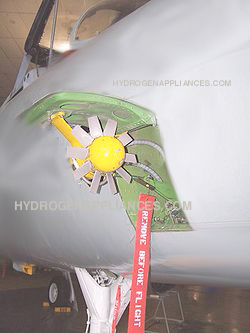 Our #APP4000
system built for air speeds up to 85 to 200 MPH
Our #APP4000
system built for air speeds up to 85 to 200 MPH
Our special 4" blades
@ 12" diameter delivers up to 4000 Watts
APP (Air Power Plant)
 CROP DUSTING POWER
PLANT
APP's have been used to power centrifugal
pumps to pressurize the spray systems on aircraft that are used
as crop dusters to deliver liquid agents to cropland. The major
reason for choosing the APP system is safety! Using an APP electric
generator allows the FAA-certified engine and power systems on
the aircraft to remain unmodified. When using the APP for your
heavy electric power needs then there is no need to use a power
take-off point on the main engine to drive the pump! The pump
can be placed low or below the exterior of the airframe greatly
simplifying plumbing, and being the lowest point in the plumbing,
it will have gravity feed from the spray tanks and never need
to be primed. In the event of a pump failure that could result
in seizure, the APP has no effect on the flying ability of the
aircraft.
CROP DUSTING POWER
PLANT
APP's have been used to power centrifugal
pumps to pressurize the spray systems on aircraft that are used
as crop dusters to deliver liquid agents to cropland. The major
reason for choosing the APP system is safety! Using an APP electric
generator allows the FAA-certified engine and power systems on
the aircraft to remain unmodified. When using the APP for your
heavy electric power needs then there is no need to use a power
take-off point on the main engine to drive the pump! The pump
can be placed low or below the exterior of the airframe greatly
simplifying plumbing, and being the lowest point in the plumbing,
it will have gravity feed from the spray tanks and never need
to be primed. In the event of a pump failure that could result
in seizure, the APP has no effect on the flying ability of the
aircraft.
SAFETY FIRST! This is the main reason to
use the APP type power plants for your crop duster!
#APP4000 -Only $1999.95 plus $74.50 S&H fee. 
 Here is our famous "APP9000" system
Here is our famous "APP9000" system
built for air speeds up
to 350 MPH speeds.
Special 9" hub with
8" long titanium blades
delivers up to 4000 Watts
on deployment.
Military and commercial
uses:
4000 WATTS OF EMERGENCY POWER
CAN BE USED TO POWER:
 Our #APP4000
system built for air speeds up to 85 to 200 MPH
Our #APP4000
system built for air speeds up to 85 to 200 MPH
 CROP DUSTING POWER
PLANT
CROP DUSTING POWER
PLANT
![]()
 Here is our famous "APP9000" system
Here is our famous "APP9000" system


